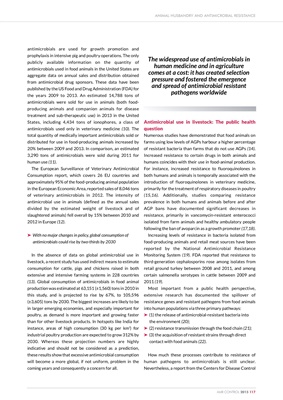
antimicrobials are used for growth promotion and
prophylaxis in intensive pig and poultry operations. The only
publicly available information on the quantity of
antimicrobials used in food animals in the United States are
aggregate data on annual sales and distribution obtained
from antimicrobial drug sponsors. These data have been
published by the US Food and Drug Administration (FDA) for
the years 2009 to 2013. An estimated 14,788 tons of
antimicrobials were sold for use in animals (both foodproducing
animals and companion animals for disease
treatment and sub-therapeutic use) in 2013 in the United
States, including 4,434 tons of ionophores, a class of
antimicrobials used only in veterinary medicine (10). The
total quantity of medically important antimicrobials sold or
distributed for use in food-producing animals increased by
20% between 2009 and 2013. In comparison, an estimated
3,290 tons of antimicrobials were sold during 2011 for
human use (11).
The European Surveillance of Veterinary Antimicrobial
Consumption report, which covers 26 EU countries and
approximately 95% of the food-producing animal population
in the European Economic Area, reported sales of 8,046 tons
of veterinary antimicrobials in 2012. The intensity of
antimicrobial use in animals (defined as the annual sales
divided by the estimated weight of livestock and of
slaughtered animals) fell overall by 15% between 2010 and
2012 in Europe (12).
‰ With no major changes in policy, global consumption of
antimicrobials could rise by two-thirds by 2030
In the absence of data on global antimicrobial use in
livestock, a recent study has used indirect means to estimate
consumption for cattle, pigs and chickens raised in both
extensive and intensive farming systems in 228 countries
(13). Global consumption of antimicrobials in food animal
production was estimated at 63,151 (±1,560) tons in 2010 in
this study, and is projected to rise by 67%, to 105,596
(±3,605) tons by 2030. The biggest increases are likely to be
in larger emerging economies, and especially important for
poultry, as demand is more important and growing faster
than for other livestock products. In hotspots like India for
instance, areas of high consumption (30 kg per km2) for
industrial poultry production are expected to grow 312% by
2030. Whereas these projection numbers are highly
indicative and should not be considered as a prediction,
these results show that excessive antimicrobial consumption
will become a more global, if not uniform, problem in the
coming years and consequently a concern for all.
Antimicrobial use in livestock: The public health
question
Numerous studies have demonstrated that food animals on
farms using low levels of AGPs harbour a higher percentage
of resistant bacteria than farms that do not use AGPs (14).
Increased resistance to certain drugs in both animals and
humans coincides with their use in food-animal production.
For instance, increased resistance to fluoroquinolones in
both humans and animals is temporally associated with the
introduction of fluoroquinolones in veterinary medicine,
primarily for the treatment of respiratory diseases in poultry
(15,16). Additionally, studies comparing resistance
prevalence in both humans and animals before and after
AGP bans have documented significant decreases in
resistance, primarily in vancomycin-resistant enterococci
isolated from farm animals and healthy ambulatory people
following the ban of avoparcin as a growth promoter (17,18).
Increasing levels of resistance in bacteria isolated from
food-producing animals and retail meat sources have been
reported by the National Antimicrobial Resistance
Monitoring System (19). FDA reported that resistance to
third-generation cephalosporins rose among isolates from
retail ground turkey between 2008 and 2011, and among
certain salmonella serotypes in cattle between 2009 and
2011 (19).
Most important from a public health perspective,
extensive research has documented the spillover of
resistance genes and resistant pathogens from food animals
into human populations via three primary pathways:
‰ (1) the release of antimicrobial-resistant bacteria into
the environment (20);
‰ (2) resistance transmission through the food chain (21);
‰ (3) the acquisition of resistant strains through direct
contact with food animals (22).
How much these processes contribute to resistance of
human pathogens to antimicrobials is still unclear.
Nevertheless, a report from the Centers for Disease Control
ANIMAL HUSBANDRY AND ANTIMICROBIAL RESISTANCE
AMR CONTROL 2015 117
The widespread use of antimicrobials in
human medicine and in agriculture
comes at a cost: it has created selection
pressure and fostered the emergence
and spread of antimicrobial resistant
pathogens worldwide